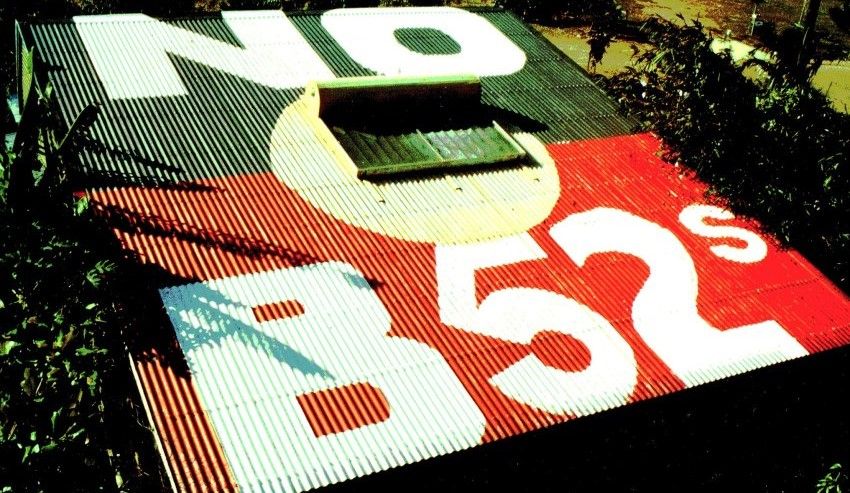
“Deterrence is the art of producing in the mind of the enemy the fear to attack,” says the maniacal Dr Strangelove (Peter Sellers) in the 1964 Stanley Kubrick anti-war classic movie Dr Strangelove, Or How I Learned To Stop Worrying And Love The Bomb.
The film, released at the height of the Cold War just two years after the Cuban missile crisis, reflected the rising global anti-war sentiment.
Those watching the October 31 ABC Four Corners program, which revealed the United States’ plan to deploy six nuclear-capable B-52 bombers to the Tindal Air Base near Darwin, were reminded that the war madness remains as real as ever.
We saw a young and wild-eyed cast of war-crazy conservatives talking excitedly about simulated war between the US and China — which, they readily admit, would end very badly for all sides.
In some simulations, pre-emptive nuclear strikes reach US territory, though the greatest casualties would, of course, be in China and other Asia-Pacific countries.
For these US war gamers from the Center for Strategic and International Studies, the Center for New American Security, the America Enterprise Institute and the RAND Corporation, even the prospect of nuclear obliteration of Okinawa, Guam and other key regional US military bases are pieces on the game board.
They are “gaming” an imagined Chinese invasion of Taiwan and the response of the US and its military allies, including Australia. For years now, this fear has been forced down our throats, even though more serious commentary admits such an invasion is unlikely.
China is the world’s biggest trading partner and exporter and such a war would not serve its economic development.
Cutting through the war propaganda about Chinese aggression, the Xi Jinping government is, in fact, defending a compromise China made with the US in 1972.
Under the Richard Nixon administration, China agreed to seek peaceful reunification with Taiwan, in return for the US recognising that Taiwan is part of China and refraining from supporting any move to formally declare Taiwanese independence.
It is the US that is seeking to break this agreement. The reason for the shift is simple: China’s economic and military development. This much is admitted in several reports, including the US-China Economic and Security Review Commission 2021 report to Congress.
Anti-China propaganda repeatedly points to Chinese officials statements over the past couple of years that they will forcefully resist threats to China’s sovereignty. Left out, however, are the string of US provocations that prompted each warning from China.
They also leave out that the US war drive in the Asia-Pacific began escalating sharply even before the Barack Obama administration’s 2012 pivot to Asia. President George W Bush announced in 2005 it would station 60% of its submarine fleet in Asia.
The objective then, and now, was to preserve US military dominance in the region.
Obama’s pivot built on Hilary Clinton’s 2011 article “America’s Pacific Century” in Foreign Policy, which identified the Asia-Pacific as the home of the “key engines of economic growth” in this century. That is why, she argued, the US had to keep its military supremacy in the region.
War, as ever, is economics by another means.
Since then, Coalition and Labor governments have eagerly agreed to the US stationing more and more of its military forces in Australia. There is also bipartisanship on the US upgrade of its global spying and communications monitoring capacity at Pine Gap, through the secretive Five Eyes alliance, as well as Australia signing on to AUKUS and the nuclear-powered submarine club.
Stationing B-52s here — which has never been reported by any Australian government, let alone gone before parliament — is just the latest step.
But back to the wild-eyed war gamers on Four Corners.
Never mind that all their simulations of war between the US and its allies against China ended up with both sides (and the civilian populations) paying a terrible cost; the conservative commentators all agreed the US and its allies should build up their military machinery and stockpile more ammunition — from bullets to the most sophisticated and deadly missiles.
This is music to the ears of the arms manufacturing corporations. War profiteering is a booming business. Just ask the oil and gas companies, which are estimated to have made windfall profits of $40 billion, just in Australia, from the war in Ukraine.
Green Left is totally opposed to the anti-China war drive and the Cold War-style propaganda blitz being used to sell it. We say the money should instead be used to address the climate emergency and urgent social needs. If you agree with us, become a supporter and make a donation to our Fighting Fund.